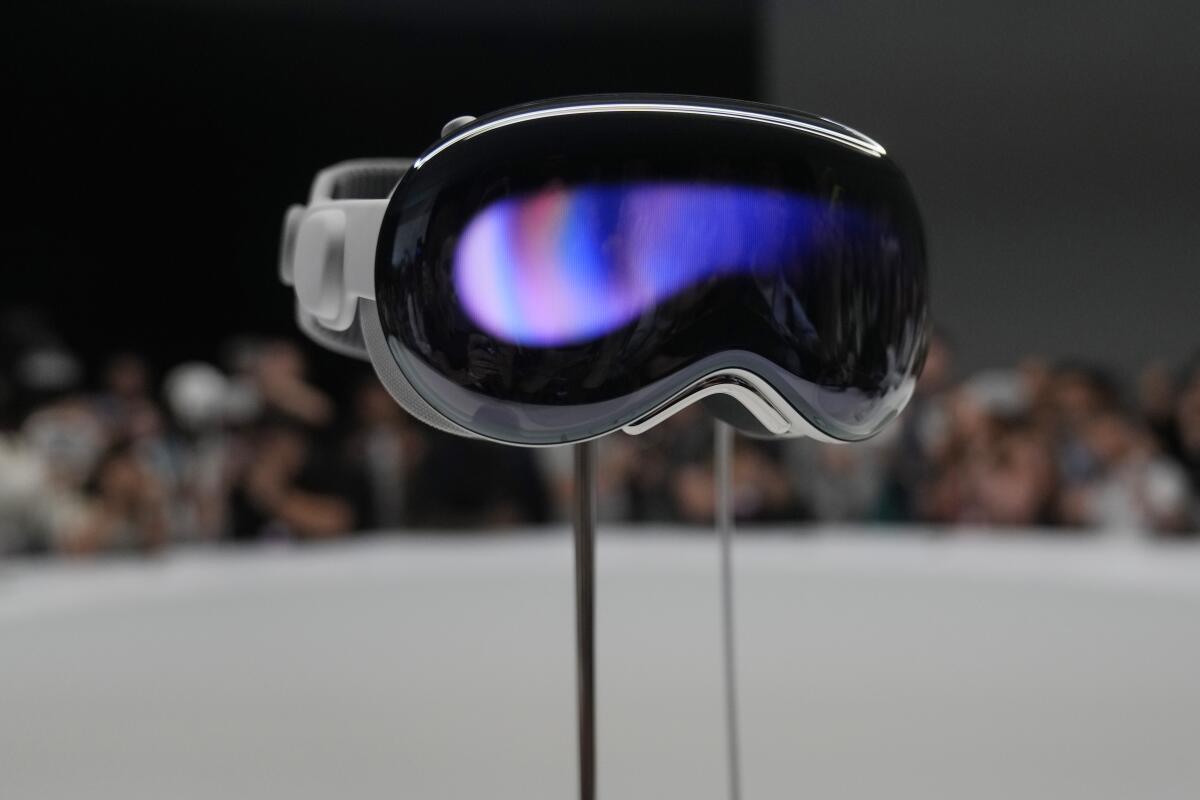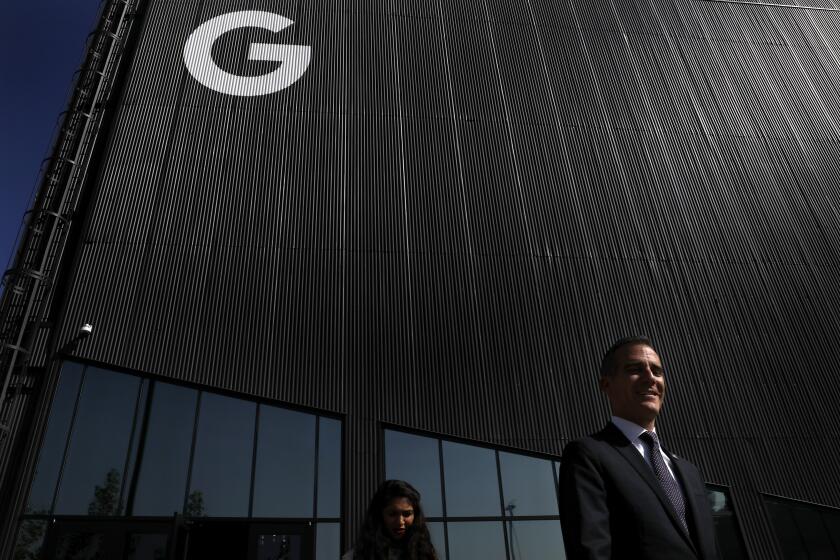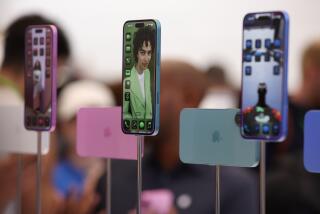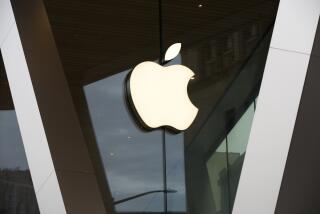Apple unveils sleek, $3,500 Vision Pro goggles. Will they be what VR has been looking for?

- Share via
CUPERTINO, Calif. — Apple on Monday unveiled a long-rumored headset that will place its users between the virtual and real worlds, while also testing the technology trendsetter’s ability to popularize newfangled devices after others failed to capture the public’s imagination.
After years of speculation, Apple Chief Executive Tim Cook hailed the arrival of the sleek goggles — dubbed Vision Pro — at the company’s annual developers conference, held on a park-like campus here that Apple’s late co-founder Steve Jobs helped design. The device will be capable of toggling between virtual reality, or VR, and augmented reality, or AR, which projects digital imagery while users still can see objects in the real world.
“This marks the beginning of a journey that will bring a new dimension to powerful personal technology,” Cook told the crowd.
Although Apple executives provided an extensive preview of the headset’s capabilities during the final half-hour of Monday’s event, consumers will have to wait before they can get their hands on the device — and prepare to pay a hefty price to boot. Vision Pro will sell for $3,500 once it’s released in stores early next year.
“It’s an impressive piece of technology, but it was almost like a tease,” Gartner analyst Tuong Nguyen said. “It looked like the beginning of a very long journey.”
Instead of merely positioning the goggles as another vehicle for exploring virtual worlds or watching more immersive entertainment, Apple framed the Vision Pro as the equivalent of owning an ultrahigh-definition TV, surround-sound system, high-end camera and state-of-the-art camera bundled into a single piece of hardware.
“We believe it is a stretch, even for Apple, to assume consumers would pay a similar amount for an AR/VR headset as they would for a combination of those products,” D.A. Davidson analyst Tom Forte wrote in a Monday research note.
Despite such skepticism, the headset could become another milestone in Apple’s lore of releasing game-changing technology, even though the company hasn’t always been the first to try its hand at making a particular device.
After Uber and other gig giants failed to pay a mandated rate hike, two eagle-eyed drivers started asking questions — and won a jackpot for California gig workers.
Apple’s lineage of breakthroughs dates to a bow-tied Jobs peddling the first Mac in 1984 — a tradition that continued with the iPod in 2001, the iPhone in 2007, the iPad in 2010, the Apple Watch in 2014 and its AirPods in 2016.
The company emphasized that it drew upon its previous decades of product design during the years it spent working on the Vision Pro, which Apple said involved more than 5,000 patents. The goggles will be equipped with 12 cameras, six microphones and a variety of sensors that will allow users to control it and various apps with just their eyes and hands. Apple also developed a technology to create a 3-D digital version of each user to display during video conferencing.
Although Vision Pro won’t require physical controllers that can be clunky to use, the goggles will have to be plugged into either a power outlet or a portable battery tethered to the headset — a factor that could make it less attractive for some users.
“They’ve worked hard to make this headset as integrated into the real world as current technology allows, but it’s still a headset,” said Insider Intelligence analyst Yory Wurmser, who nevertheless described the unveiling as a “fairly mind-blowing presentation.”
Even so, analysts are not expecting the Vision Pro to be a big hit right away. That’s largely because of the hefty price, but also because most people still can’t see a compelling reason to wear something wrapped around their face for an extended period.
If the new device turns out to be a niche product, it would leave Apple in the same bind as other major tech companies and startups that have tried selling headsets or glasses equipped with technology that thrusts people into artificial worlds or projects digital images with scenery and things that are actually in front of them.
Facebook founder Mark Zuckerberg has been describing these alternate 3-D realities as the “metaverse.” It’s a geeky concept that he tried to push into the mainstream by changing the name of his social networking company to Meta Platforms in 2021 and then pouring billions of dollars into improving the virtual technology.
But the metaverse largely remains a digital ghost town, although Meta’s virtual reality headset, the Quest, remains the top-selling device in a category that has mostly appealed to video game players looking for even more immersive experiences. Cook and other Apple executives avoided referring to the metaverse in their presentations, describing the Vision Pro as the company’s first leap into “spatial computing” instead.
Snack’s new AI feature lets chatbots handle the initial getting-to-know-you conversations with potential suitors. It’s as strange as it sounds.
The response to virtual, augmented and mixed reality has been decidedly ho-hum. Some of the gadgets deploying the technology have been derisively mocked, with the most notable example being Google’s internet-connected glasses released more than a decade ago.
After Google co-founder Sergey Brin initially drummed up excitement about the device by demonstrating an early model’s potential “wow factor” with a skydiving stunt staged during a San Francisco tech conference, consumers quickly became turned off to a product that allowed its users to surreptitiously take pictures and video. The backlash became so intense that people who wore the gear became known as “Glassholes,” leading Google to withdraw the product a few years after its debut.
Microsoft also has had limited success with HoloLens, a mixed-reality headset released in 2016, although the software maker earlier this year insisted it remains committed to the technology.
Magic Leap, a startup that stirred excitement with previews of a mixed-reality technology that could conjure the spectacle of a whale breaching through a gymnasium floor, had so much trouble marketing its first headset to consumers in 2018 that it has since shifted its focus to industrial, healthcare and emergency uses.
Daniel Diez, Magic Leap’s chief transformation officer, said there are four major questions Apple’s goggles will have to answer: “What can people do with it? What does this thing look and feel like? Is it comfortable to wear? And how much is it going to cost?”
Increasingly offering products untethered to the average consumer’s needs, the tech industry has been dwelling in La La Land. Its real-world expansion into L.A. is no coincidence.
The anticipation that Apple’s goggles are going to sell for several thousand dollars already has dampened expectations for the product.
Although he expects Apple’s goggles to boast “jaw dropping” technology, Wedbush Securities analyst Dan Ives said he expects the company to sell just 150,000 units during the device’s first year on the market — a mere speck in the company’s portfolio.
By comparison, Apple sells more than 200 million of its marquee iPhones a year. But the iPhone wasn’t an immediate sensation, with sales of fewer than 12 million units in its first full year on the market.
Since 2016, the average annual shipments of virtual- and augmented-reality devices have averaged 8.6 million units, according to the research firm CCS Insight. The firm expects sales to remain sluggish this year, with a sales projection of about 11 million of the devices before gradually climbing to 67 million in 2026.
Before taking the wraps of its new goggles, Apple kicked off the event by announcing that the latest models of two high-end computer lines, the Mac Studio and Mac Pro, will be powered by a company-designed chip that has already been available in less-expensive Macs.
The Mac Studio will sell for $2,000 and the Mac Pro will be priced at $7,000. As it typically does at this conference, Apple provided a peek at the next iPhone operating system, iOS 17. That software, which will include more personalization and location-sharing tools for phone calls and texting, is expected to be released as a free update in September.
More to Read
Inside the business of entertainment
The Wide Shot brings you news, analysis and insights on everything from streaming wars to production — and what it all means for the future.
You may occasionally receive promotional content from the Los Angeles Times.













